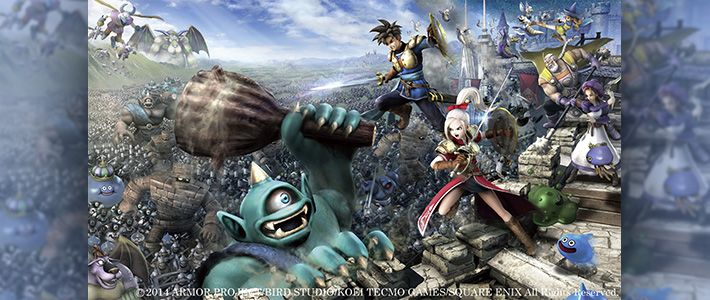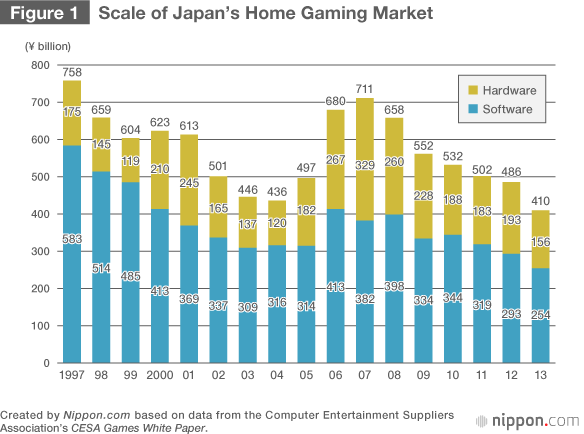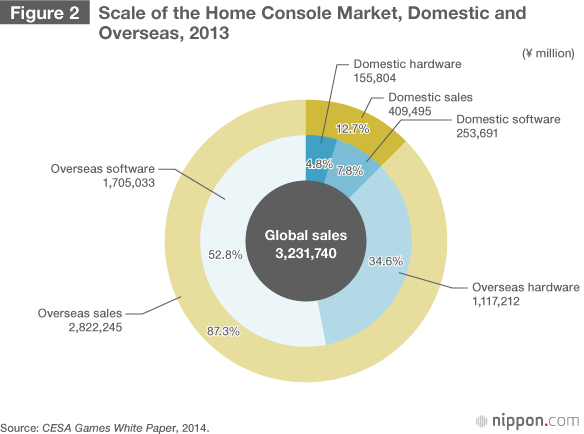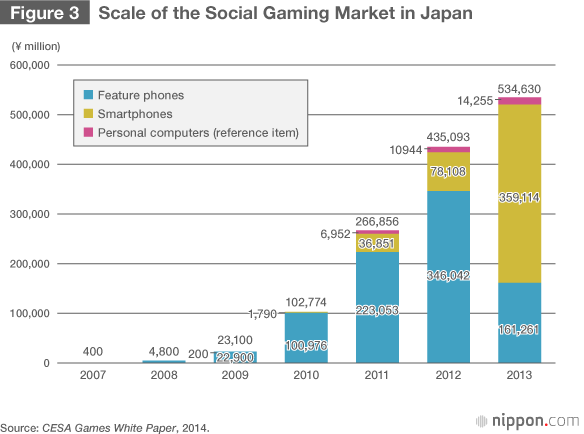
Japan’s Game Industry Jumps to New Platforms
Video Games: A Winning Strategy for Japan
Economy Society Culture- English
- 日本語
- 简体字
- 繁體字
- Français
- Español
- العربية
- Русский
How Is Japan’s Video Game Industry Faring?
These days we often hear talk of the poor health of Japan’s video game industry. The consensus that the industry is ailing is presumably related in part to the string of three annual consolidated losses at Nintendo. In the past Nintendo and other Japanese companies dominated the world’s video game market. But in recent years firms based in other countries, particularly the United States, have been increasing their market share, and they have also taken the lead in technology. So it is true that the former leading Japanese firms have seen their positions slip in some respects, as I will explain below.
Viewed from a different angle, however, the Japanese game industry, far from being in decline, is actually on a roll, showing signs of shining as the global center of this sector. Today “soft power” is in the limelight. In this context, we need to reexamine the strength of Japan’s video game industry without being misled by the gloomy consensus. In this article I will consider the big picture, offering an overview of the industry’s current state and discussing its Japanese identity.
In Retrospect: The Rise of Nintendo and Sony
The video game industry was born in the United States. In 1972 Atari, a California-based company, put Pong on the market. This was the world’s first commercial video game. Building on its popularity, Atari came out with a home gaming console, which was also a hit, and for the rest of the 1970s America dominated the video game world.
In the 1980s, however, the picture changed. Atari’s market collapsed in the wake of sales of inferior software, and this “Atari shock” (also called the video game crash of 1983) caused the price of shares in Warner Brothers, its parent company, to plunge. Japan’s Nintendo emerged as the new industry leader. In 1983 Nintendo launched the Family Computer (Famicom) home gaming console, and five years later it put it on sale in North America as the Nintendo Entertainment System. NES became the world’s top gaming console, and the name Nintendo became synonymous with video games in countries around the world. The 1980s became the decade of Japan for this industry, and the Japanese lead continued through the 1990s, with Sony Entertainment coming out with its PlayStation and enjoying success rivaling that of Nintendo.
Long-Term Decline in Demand for Gaming Consoles
After the turn of the century, the US game industry came zooming back. The 2000s brought rapid advances in the performance of gaming hardware. Sony Computer Entertainment produced PlayStation 2 and 3, and Microsoft entered the fray with the Xbox and Xbox 360. The improvements in hardware worked to the advantage of US companies, which had strengths in the basic technology for computer graphics. In addition, the first decade of the new century saw a dramatic increase in the number of people involved in game development. A single game could cost tens of millions of yen and require a team of hundreds or even more than a thousand people to produce. Engineers in the United States, with their experience in implementing large-scale information-technology projects, were well suited to such undertakings. So the 2000s became the decade of a US comeback in the game industry.
Following the 1983 debut of Nintendo’s Family Computer, the Japanese market for video games grew steadily through 1997, when annual sales (hardware plus software) topped ¥750 billion. But after this the industry entered a period of decline, and as of 2013 sales had fallen to a bit over ¥400 billion. On the global scene, meanwhile, Japanese firms’ share of the market is now only about 13%. So, to sum up, the market for gaming consoles is experiencing a long-term decline, which has pushed Nintendo, formerly a star performer, into the red. In this respect, the Japanese video game industry can indeed be said to be doing poorly.


On Top in the Global Market for Mobile Games
In another respect, however, the Japanese video game industry is not declining but rather thriving in a Japanese way. Gaming devices come in two main types: home consoles that are attached to television sets and handheld game consoles. The handheld variety accounts for only about 20% of the market in other countries, but in Japan it has a share of over 50%. The popularity of handheld units has been supported by mega-hit games like Pokémon and Yo-Kai Watch. It is also often suggested that these portable units sell well in this country because the Japanese have a predilection for compact, lightweight electronic devices like the Sony Walkman, and because many people are in the habit of playing video games while commuting.
And Japan, where this sort of portable culture has taken root, now leads the world in the market for mobile games (games played on smartphones or other mobile phones). According to International Data Group, a major US research company, the global market for mobile games came to $14.7 billion in 2013. At ¥120 to the dollar, this amounts to ¥1,764 billion. So the domestic Japanese market of about ¥550 billion accounts for roughly one-third of the global total.

The iPhone was put on the market in Japan in 2008. The following year Mixi, a major Japanese social networking site, launched a social gaming service, and the mobile social gaming market, which at that point was worth only about ¥23 billion, subsequently ballooned. The vigor of the Japanese video game industry has shifted over the past few years from home gaming to mobile gaming.
Video Games and the Japanese Aesthetic of Distortion
So far I have been discussing developments relating to gaming hardware and market shifts. Next I would like to touch on software-related aspects.
Japan’s video game software is highly distinct from that of other countries. A key point is that high-performance gaming devices have met with a chilly reception in the Japanese market. This reflects Japanese users’ tendency not to care for realism. PlayStation 4 supports graphics so realistic that they almost look like live-action video. Users in the United States and other countries eagerly went for this, but in Japan it was a different story. It seems that the Japanese tend to prefer artistically distorted (déformé) representations over photorealism.
Advances in hardware technology have made it possible for game creators to present three-dimensional objects and action with any desired degree of realism, but Japanese users show no interest in such graphics. Popular Japanese game series like Pokémon, Monster Hunter, and Dragon Quest are far from realistic in their depictions. The same goes for mobile games. The games that are popular in Japan, such as Puzzle and Dragons, are all two-dimensional.
In the past, when games like Super Mario Bros. and Tetris became global hits, people said that the draw of video games was borderless. But as the developers’ powers of expression grew and their techniques became more varied, country-to-country differences emerged in the concepts of what a video game should be and in ideas of how games should be depicted. The contents of the hits came to reflect the culture of the nation.
The video games that are widely played in Japan today seem to be rooted in Japan’s distinctive culture of painting and video imagery. This is the culture that produced the Chōjū-jinbutsu-giga (Scrolls of Frolicking Animals and Humans) in the twelfth and thirteenth centuries, the genre of ukiyo-e in the Edo period (1603–1868), and today’s manga and anime. Born in Japan and long appreciated by Japanese people, it is an aesthetic culture that cares little for 3D images. Beauty is found in representations that are two-dimensional at first glance but that allow the viewer to imagine spatial depth and physical solidity.
European artists of the Renaissance learned the techniques of geometric and aerial perspective, with which they sought to draw solid objects realistically. But Japanese painters did not seek this sort of realism. As seen in the genre of ukiyo-e, they stressed the enjoyment of prominent symbolism. A similar sort of aesthetic informs today’s Japanese video games.
Gun Culture, Sword Culture
Aside from the difference between flat and 3D imagery, another key factor in determining whether or not games become hits in Japan is the presence—or, rather, the absence—of guns.
Ever since the appearance of Space Invaders in 1978, the idea of aiming at opponents and shooting them has become an accepted part of video games around the world. This is a very simple type of gameplay. Many such games, with spaceships and tanks shooting at enemies, were developed in Japan and went on to become hits in other countries. Notable examples are Xevious and Gradius.
In the 1990s “first-person shooter” games came onto the market. Developed mainly in the United States, FPS games put the player in the position of shooting at human opponents with a gun or other firearm. Though popular elsewhere, none of these games have become hits in Japan; for the past two decades Japanese users have been avoiding them. The common explanation for this phenomenon has been that Japan does not have a gun culture.
So what is a “gun culture”? Here I would like to suggest that the United States, the principal source of FPS games and the biggest market for them, is a country of guns. According to a 2014 Gallup poll, 42% of American households own guns. The right to own them is enshrined in the Second Amendment of the US Constitution. The lyrics of “The Star-Spangled Banner,” America’s national anthem, refer to “bombs bursting in air.” Both in legal terms and in real life, the place of guns is completely different from what it is in Japan.
If the United States is a country of guns, Japan might be called a country of swords. Japan used to have guns too, but they were used only in warfare; the weapon into which the samurai put his soul was the sword. Though this may seem like a forced interpretation, the fact that the FPS genre of video games that is popular in the United States has failed to gain a Japanese following may be because Japan does not have a gun culture. Japanese people do not “get” guns.
Swords are another matter. Role-playing games involving fighting with cold weapons are big in Japan. And as players progress from carrying a club to wielding a dagger, a regular sword, and finally a legendary sword, they can feel a sense of personal growth. But Americans, who see daggers and swords as less efficient weapons than guns, find role-playing games frustrating and cannot really get into them
Focus on Japanese-Style Content
The Japanese video game industry is approaching a major turning point. The overseas game market is expanding, and demand for both gaming devices and smartphone games is now growing in the emerging countries of Asia, South America, and elsewhere. Meanwhile, Japanese game producers have been forced to adopt a two-track approach, producing games both for the domestic market and for users outside of Japan. So even as they continue to turn out role-playing games for Japanese gamers, they have a separate development crew doing international market research and turning out products like FPS games aimed at users overseas.
Talented Japanese game creators are capable of turning out reasonably good games for the international market, but the results seem somewhat forced. As game companies have pursued this woolly two-track approach, Japanese games have become less popular. And as I noted at the outset, people are saying that the Japanese game industry, which used to lead the world, is in poor health.
When I say that the industry is at a turning point, I mean that the time has come to concentrate on producing Japanese-style games. FPS may be the most popular genre in Europe and North America, but if we look at the global market as a whole, including emerging countries, we find that there are plenty of users who are not into this genre. Even within the United States, some users choose games from Japan over American-made games. In France there are users who even go for Japanese games that are relatively minor on the domestic scene and who flock to events like Japan Expo dressed up as game characters. Japanese-style games are especially popular in Asian markets like Taiwan, Thailand, Indonesia, and Malaysia.
Instead of trying to sell to users hungry for realistic graphics and steeped in gun culture, Japan’s video game industry should reach out to potential fans of Japanese-style games and nurture their interest in the genre. We need a new Cool Japan strategy for game software.
(Originally published in Japanese on April 7, 2015. Banner photo: Dragon Quest Heroes, a new release in the popular Dragon Quest role-playing game series from Square Enix. © Jiji.)
video games Mobile Nintendo Sony SNS smartphones Mixi NES Yo-Kai Watch Pokemon Puzzle and Dragons FPS